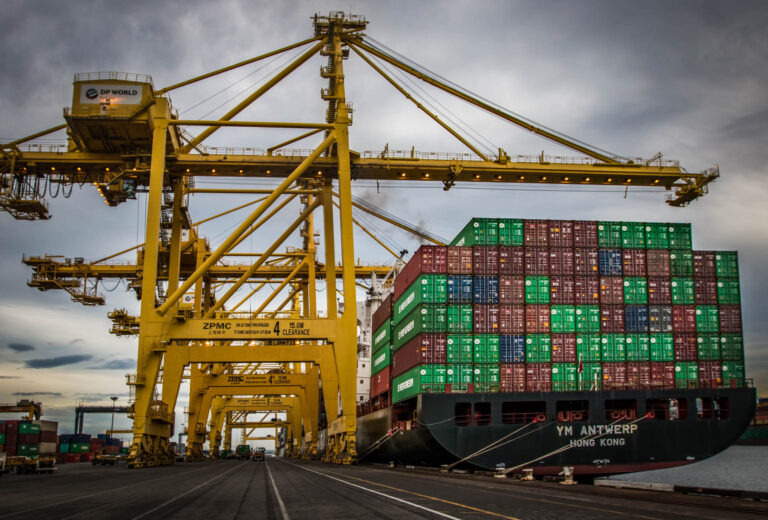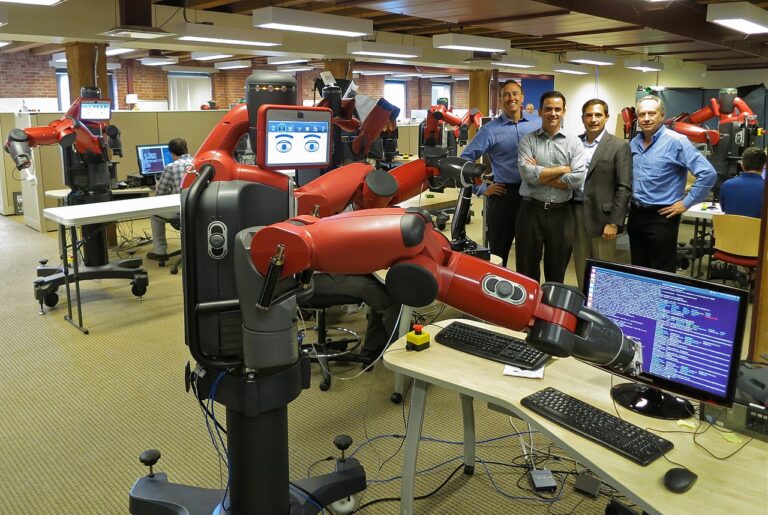
Samantha Schwartz is a student at Harvard Law School.
Image Credit: Max Gruber / Better Images of AI / Clickworker Abyss / CC-BY 4.0
AI has the potential to improve the quality of work, but right now, it seems to be making it worse. Why is that? And how can we ensure the proliferation of AI in the workplace has the benefits its proponents promise?
Over the past forty years, companies have learned how to evade employment obligations while retaining control over workers, a practice David Weil coined “workplace fissuring.” “Fissuring” refers to lead firms shifting their employment obligations onto external firms, while retaining control over the production of goods and services via restrictive, standardized contract terms. As a result, the entities that determine the quality of a work experience are increasingly not the legal employer of the workers in question, stripping workers’ rights against those who determine their working conditions.
Workplace fissuring generates demand for information technology that can monitor and control workers from a distance. Recent advancements in artificial intelligence respond to that demand. AI applications such as algorithmic management systems enable the lead firm in a fissured workplace to direct the work of their non-employee affiliates to the extent that usually creates an employment relationship, but from an artificial distance that vitiates legal claims that an employment relationship exists. Proponents of algorithmic management programs paint them as “a promising approach to achieve their organization’s goals through higher worker performance and[] cost savings.” Meanwhile, extensive monitoring and digital control degrades job quality by increasing work intensity, monotony, and discrimination and decreasing human engagement, dignity, and agency.
How Does AI Enable Workplace Fissuring?
The adoption of workplace AI tools creates a positive feedback loop, wherein incentives to maximize control while minimizing costs create demand for algorithmic management tools, and such tools enable firms to fissure away more work in more industries than before.
Subcontracting
Businesses often fissure by subcontracting, where a lead business contracts out increasingly core functions to subordinate businesses who can further contract out their activities. AI systems help lead businesses monitor subordinate businesses’ adherence to their preferences.
For example, a Colombia-based call center that provides subcontracted services to major companies, including Amazon, Uber, and Apple, installed cameras in remote workers homes. An AI model scans a video feed for breaches of work rules and sends screengrabs of infractions to managers or marks workers “idle” if they don’t click or type within a certain time frame. The center adopted the system at the request of some of its clients, illustrating that the entity not legally classified as the surveilled workers’ employer nonetheless shapes their working conditions by adopting AI-enabled monitoring systems.
Independent Contractors
For virtually any task that doesn’t require teamwork, lead and subcontracted businesses in fissured workplaces contract individual independent contractors, rather than hire employees. Independent contractors are increasingly hired and managed through apps on their smartphones, enabling individualized monitoring and direction with the illusion of independence. For example, delivery apps track workers’ accuracy, speed, adherence to scripted language, and customer ratings, sometimes calculating pay based on these metrics. In the trucking industry, AI-equipped dash cams and microphones track drivers’ locations, driving behaviors, seatbelt use, and facial expressions for fatigue and distraction.
Franchising
In franchises, a lead business, the franchisor, maintains overall control of brand management but separate businesses, franchisees, carry out the business’s core activities and pay revenue-linked royalties to the franchisor. Because franchisors impose restrictive contract terms on franchisees, franchisees primarily retain control over their profit margins by manipulating labor costs, resulting in high productivity demands and frequent labor violations.
Driven by these incentives, each of the major franchised industries, janitorial services, hotels, and restaurants, have adopted algorithmic management systems. These systems can identify humans and objects in video feeds, assign tasks, require worker verification of task completion, detect rule violations, generate predictions of customer experience, and alert managers to initiate discipline.
Supply Chains
Some businesses fissure by shifting tasks down their supply chains, wherein a lead business coordinates a network of subsidiary organizations that provide goods and services essential to the lead business’s final product. Warehouses and distribution centers, key elements of supply chains, have been pioneers of algorithmic management systems. These systems use barcode scanners’ data to track scan rates and errors, send notifications to workers to increase their pace or accuracy, and sometimes show productivity scores on “leaderboards” in the workplace. Some warehouses also use autonomous mobile robot picking carts (sometimes called “lead me” carts) that direct workers’ tasks and set their pace of work.
How has AI-enabled fissuring affected job quality?
Though AI-enabled workplace fissuring may have short term productivity gains, the detriments to job quality impose costs that will likely outweigh them. AI-enabled fissuring intensifies the pace of work while constantly monitoring workers, increasing stress levels and injury rates, and decreasing worker autonomy, innovation, and productivity.
Workplace fissuring also depresses wages. The smaller firms on the outer orbit of a fissured workplace face pressure to cut costs by violating labor laws and they don’t benefit from the lead business’s growth, let alone pass it onto their employees.
And, such arrangements diminish workers’ bargaining power. AI systems collect vast performance data on each worker, but workers often don’t know and can’t access what’s collected, so workers seeking new jobs (given reduced opportunities for promotion within a fissured workplace) cannot demonstrate past performance to prospective employers. AI-enabled fissuring also impedes unionization by creating multiple smaller workplaces, and employers have used AI tools to profile and suppress potential organizers.
Finally, algorithmic management systems exacerbate discrimination by perpetuating biases in the workplace data on which they were trained, while obscuring the source of discrimination and leaving workers without clear paths to redress.
Yet, where workplace AI tools are not used to identify, direct, and evaluate individual workers, they can improve worker safety by detecting hazards and ergonomic risks.
Recommended Legal Reforms
Employment law reform efforts should institute joint employer responsibility of lead businesses over the workers they control in their fissured workplace. The existing “joint employer” definition considers “direct and immediate control” over workers, so strategic litigators should seek to establish that algorithmic direction is evidence of direct control.
Labor law reform efforts should seek to replace the enterprise-level bargaining system with a sectoral bargaining system to give unions the right to bargain with the entities throughout their fissured workplace that control their working conditions.
Finally, certain workplace technology rights must be codified. Given that modern AI tools are largely unregulated, paving a one-way street for businesses to extract data from workers, digital rights efforts should empower workers with knowledge and a voice in the “datafied” workplace. Reforms should include 1) mandating disclosures to workers on data collection and usage, 2) facilitating worker input on implementation of AI systems, and 3) requiring data anonymization such that AI systems only reflect organizational efficiency or provide safety instructions, rather than evaluate individual workers.
Conclusion
Proponents of workplace AI applications tout the tools’ potential to improve the quality of work, but the existing economic and legal landscape that has incentivized erosion of the direct employment relationship promises that firms’ adoption of workplace AI tools will have the opposite effect. To respond, reforms must modernize workplace regulation to mitigate evasion of employment responsibility and restore the reciprocal duty of employment.







Daily News & Commentary
Start your day with our roundup of the latest labor developments. See all
December 7
Philadelphia transit workers indicate that a strike is imminent; a federal judge temporarily blocks State Department layoffs; and Virginia lawmakers consider legislation to repeal the state’s “right to work” law.
December 5
Netflix set to acquire Warner Bros., Gen Z men are the most pro-union generation in history, and lawmakers introduce the “No Robot Bosses Act.”
December 4
Unionized journalists win arbitration concerning AI, Starbucks challenges two NLRB rulings in the Fifth Circuit, and Philadelphia transit workers resume contract negotiations.
December 3
The Trump administration seeks to appeal a federal judge’s order that protects the CBAs of employees within the federal workforce; the U.S. Department of Labor launches an initiative to investigate violations of the H-1B visa program; and a union files a petition to form a bargaining unit for employees at the Met.
December 2
Fourth Circuit rejects broad reading of NLRA’s managerial exception; OPM cancels reduced tuition program for federal employees; Starbucks will pay $39 million for violating New York City’s Fair Workweek law; Mamdani and Sanders join striking baristas outside a Brooklyn Starbucks.
December 1
California farmworkers defend state labor law, cities consider requiring companies to hire delivery drivers, Supreme Court takes FAA last-mile drivers case.